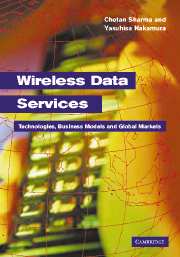Book contents
- Frontmatter
- Contents
- List of figures
- About the authors
- Foreword
- Acknowledgements
- List of abbreviations
- 1 Introduction
- 2 The impact of globalization
- 3 Adoption trends and analysis by region
- 4 Subscriber needs and expectations
- 5 The wireless value chain
- 6 Global wireless technologies: systems and architectures
- 7 Global wireless technologies: network, access, and software
- 8 Business models and strategies
- 9 Business issues and challenges
- 10 Technology issues and challenges
- 11 Case studies
- 12 Perspectives
- 13 Future of wireless technologies, applications and services
- 14 Conclusions and recommendations
- References and recommended reading
- Index
13 - Future of wireless technologies, applications and services
Published online by Cambridge University Press: 06 August 2009
- Frontmatter
- Contents
- List of figures
- About the authors
- Foreword
- Acknowledgements
- List of abbreviations
- 1 Introduction
- 2 The impact of globalization
- 3 Adoption trends and analysis by region
- 4 Subscriber needs and expectations
- 5 The wireless value chain
- 6 Global wireless technologies: systems and architectures
- 7 Global wireless technologies: network, access, and software
- 8 Business models and strategies
- 9 Business issues and challenges
- 10 Technology issues and challenges
- 11 Case studies
- 12 Perspectives
- 13 Future of wireless technologies, applications and services
- 14 Conclusions and recommendations
- References and recommended reading
- Index
Summary
The future isn't what it used to be.
Arthur C. ClarkeMy interest is in the future because I am going to spend rest of my life there.
Charles KetteringIntroduction
This chapter aims to focus on the discussion of future of wireless technologies, applications, and services in the twentyfirst century. In Chapter 10, we discussed some of the technology issues and challenges for the industry. In this chapter, we will continue the discussion on the evolution and challenges of wireless technology in the context of the next 5–10 years. Several industry standards groups made up of manufacturers, carriers and academic institutions – including the IPv6 Forum, SDR Forum, 3GPP, Internet Engineering Task Force (IETF), and the Wireless World Research Forum – are helping to formulate a vision of a next-generation wireless world. Manufacturers and carriers are already looking to build on existing 3G specifications. AT&T has been developing a network prototype called 4G Access that combines Enhanced Data Rates for GSM Evolution (EDGE) with wideband orthogonal frequency division multiplexing (OFDM). Nortel has been working on software radio power amplifier technology needed to make higher wireless speeds a reality, and the streaming media research group of HP Labs has been working on systems for delivering multimedia content over next-generation networks.
Several companies are funding wireless research activities at the University of California. NTT DoCoMo research labs are constructing a trial 4G network based on the ITU's proposals. The system combines variable spreading factor (VSF) and OFDM technologies.
- Type
- Chapter
- Information
- Wireless Data ServicesTechnologies, Business Models and Global Markets, pp. 288 - 329Publisher: Cambridge University PressPrint publication year: 2003

